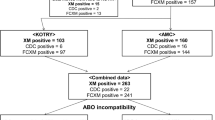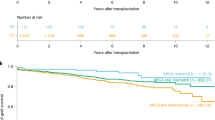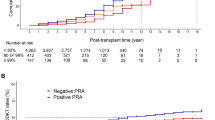Abstract
Given the severe shortage of deceased-donor organs in Japan, the use of living-donor kidney transplantation (LKT) strategies, such as ABO-incompatible living-donor kidney transplantation, has expanded rapidly. ABO-incompatible LKT was initially performed following splenectomy and antibody removal; however, immunosuppressive protocols for ABO-incompatible LKT have changed markedly over recent years in Japan. Mycophenolate mofetil, calcineurin inhibitors and corticosteroids are now used to achieve desensitization before transplantation, and thereby suppress acute antibody-mediated rejection. In addition, many institutions now use anti-CD20 antibody (rituximab) instead of splenectomy, which seems to have markedly reduced the incidence of acute antibody-mediated rejection. ABO-incompatible LKT recipients in Japan typically undergo 2–4 sessions of plasma exchange or double-filtration plasmapheresis before transplantation to remove anti-ABO antibodies. In contrast to many Western countries, antibody removal is not routinely performed after kidney transplantation in Japan. Among 1,012 ABO-incompatible LKTs carried out at 92 Japanese institutions during the period 1989–2006, 1-year, 3-year, 5-year and 10-year patient survival rates were 95%, 93%, 91% and 87%, respectively, and the corresponding graft survival rates were 90%, 86%, 80% and 63%, respectively. These data indicate that the outcomes of ABO-incompatible LKT are comparable to those of ABO-compatible LKT. This Review summarizes Japan's experience with ABO-incompatible LKT.
Key Points
-
The use of ABO-incompatible living-donor kidney transplantation (LKT) is increasing in Japan because of the shortage of deceased-donor organs, and the outcomes of this procedure are now comparable to those of ABO-compatible transplantation
-
Hyperacute rejection within 24 h of ABO-incompatible LKT is rare, but the critical period for delayed hyperacute rejection is between 2 days and 2 weeks after surgery (accommodation is established thereafter)
-
The most important objective for the prevention of delayed hyperacute rejection is ensuring that anti-ABO antibody titers are lowered sufficiently before transplantation
-
The number of antibody removal sessions is determined by antibody titer; however, as a general rule, antibody removal is not required after kidney transplantation
-
Splenectomy is useful in suppressing antibody production before the administration of potent immunosuppressants, such as mycophenolate mofetil, but use of this procedure has been declining since the introduction of rituximab; the use of rituximab and mycophenolate for desensitization seems effective and is increasing, but has not been tested in randomized controlled trials
-
Severe bacterial infection can cause antibody-mediated rejection after ABO-incompatible LKT because ABO-antigen-like substances on the surface of bacteria can serve as cross-reacting antigens; therefore, excessive immunosuppression must be avoided
This is a preview of subscription content, access via your institution
Access options
Subscribe to this journal
Receive 12 print issues and online access
$209.00 per year
only $17.42 per issue
Buy this article
- Purchase on Springer Link
- Instant access to full article PDF
Prices may be subject to local taxes which are calculated during checkout







Similar content being viewed by others
References
Japanese Society for Dialysis Therapy, Patient Registration Committee (2008) Changes in number of chronic hemodialysis patients [Japanese]. In An Overview of Regular Dialysis Treatment in Japan as of December 31, 2007 [CDROM]. Tokyo, Japan: Japanese Society for Dialysis Therapy
Yuzawa K et al. (2006) Outcome of laparoscopic live donor nephrectomy in 2005: National survey of Japanese transplantation centers. Transplant Proc 38: 3409–3411
Japanese Society for Transplantation (online 2007) Organ Transplantation Fact Book [Japanese] [http://www.asas.or.jp/jst/pdf/fct2007.pdf] (accessed 7 August 2008)
Ota K et al. (1969) Indication of kidney transplantation and selection of the donor [Japanese]. Surgical diagnosis and treatment 11: 589–595
Alexandre GP et al. (1985) Splenectomy as a prerequisite for successful human ABO-incompatible renal transplantation. Transplant Proc 17: 138–143
Alexandre GP et al. (1987) Present experiences in a series of 26 ABO-incompatible living donor renal allografts. Transplant Proc 19: 4538–4542
Ota K et al. (1992) Multicentre trial of ABO-incompatible kidney transplantation: Japanese Biosynsorb ABO-incompatible kidney transplant study group. Transpl Int 5 (Suppl 1): S40–S43
Japanese Society for Clinical Renal Transplantation and Japanese Society for Transplantation (2007) Annual progress report from the Japanese Renal Transplant Registry, 2007: Part III: results from 2006 follow-up survey [Japanese]. Jpn J Transplant 42: 545–557
Yoshimura K et al. (2003) Experience with laparoscopic splenectomy for ABO-incompatible living related renal transplantation. J Endourol 17: 751–754
Takahashi K and The Japanese ABO-incompatible Transplantation Society (2007) Present status of ABO-incompatible kidney transplantation in Japan [Japanese]. Transplantation Now 20: 552–564
Takahashi K (2005) A new concept of accommodation in ABO-incompatible kidney transplantation. Clin Transplant 19 (Suppl 14): S76–S85
Takahashi K (2001) Cases in which hyperacute humoral rejection developed during surgery as a result of transfusion with frozen plasma of the same blood type as the recipient. In ABO Incompatible Kidney Transplantation. Amsterdam, The Netherlands: Elsevier Science BV
Takahashi K (2004) Accommodation in ABO-incompatible kidney transplantation: why do kidney grafts survive? Transplant Proc 36: 193S–196S
Takahashi K (2001) A case of acute humoral rejection triggered by bacterial infection. In ABO Incompatible Kidney Transplantation. Amsterdam, The Netherlands: Elsevier Science BV
Takahashi K (2007) Recent findings in ABO-incompatible kidney transplantation: classification and therapeutic strategy for acute antibody-mediated rejection due to ABO-blood-group-related antigens during the critical period preceding the establishment of accommodation. Clin Exp Nephrol 11: 128–141
Takahashi K et al. (2004) Excellent long-term outcome of ABO-incompatible living donor kidney transplantation in Japan. Am J Transplant 4: 1089–1096
Shimmura H et al. (2000) Role of anti-A/B antibody titers in results of ABO-incompatible kidney transplantation. Transplantation 70: 1331–1335
Shimmura H et al. (2005) Lack of correlation between results of ABO-incompatible living kidney transplantation and anti-ABO blood type antibody titers under our current immunosuppression. Transplantation 80: 985–988
Mitsuhata N et al. (2006) Splenectomy and preoperative risks in ABO-incompatible kidney transplants. Transplantation 82: 719–720
Tyden G et al. (2006) The Stockholm experience with ABO-incompatible kidney transplantations without splenectomy. Xenotransplantation 13: 105–107
Montgomery RA et al. (2006) New options for patients with donor incompatibilities. Transplantation 82: 164–165
Tyden G et al. (2003) Successful ABO-incompatible kidney transplantations without splenectomy using antigen-specific immunoadsorption and rituximab. Transplantation 76: 730–731
Tyden G et al. (2007) Implementation of a protocol for ABO-incompatible kidney transplantation—a three-center experience with 60 consecutive transplantations. Transplantation 83: 1153–1155
Gloor JM et al. (2005) A comparison of splenectomy versus intensive posttransplant antidonor blood group antibody monitoring without splenectomy in ABO-incompatible kidney transplantation. Transplantation 80: 1572–1577
Aikawa A et al. (2004) Clinical outcome and accommodation in ABO incompatible kidney transplantation. Clin Transpl 135–142
Tanabe K (2007) Double-filtration plasmapheresis. Transplantation 84: S30–S32
Wilpert J et al. (2007) On-demand strategy as an alternative to conventionally scheduled post-transplant immunoadsorptions after ABO-incompatible kidney transplantation. Nephrol Dial Transplant 22: 3048–3051
Kobayashi T and Saito K (2007) Interinstitutional variation in measurement of anti-blood group A and B antibody. In The New Strategies of ABO Incompatible Transplantation. Tokyo, Japan: Nihon Igakukan
Tanabe K (2007) Interinstitutional variation in the measurement of anti-A/B antibodies: the Japanese ABO-Incompatible Transplantation Committee survey. Transplantation 84 (Suppl 12): S13–S16
Yung GP et al. (2007) Flow cytometric measurement of ABO antibodies in ABO-incompatible living donor kidney transplantation. Transplantation 84: S20–S23
Bensinger WI et al. (1981) Immunoadsorption for removal of A and B blood-group antibodies. N Engl J Med 304: 160–162
Bannett AD et al. (1987) Immunoadsorption and renal transplant in two patients with a major ABO incompatibility. Transplantation 43: 909–911
Norden G et al. (2006) ABO-incompatible live donor renal transplantation using blood group A/B carbohydrate antigen immunoadsorption and anti-CD20 antibody treatment. Xenotransplantation 13: 148–153
Donauer J et al. (2006) ABO-incompatible kidney transplantation using antigen-specific immunoadsorption and rituximab: a single center experience. Xenotransplantation 13: 108–110
Kaplan B et al. (2007) Successful rescue of refractory severe antibody mediated rejection with splenectomy. Transplantation 83: 99–100
El-Alfy MS and El-Sayed MH (2004) Overwhelming postsplenectomy infection: is quality of patient knowledge enough for prevention? Hematol J 5: 77–80
Bourgault AM et al. (1979) Severe infection due to Streptococcus pneumoniae in asplenic renal transplant patients. Mayo Clin Proc 54: 123–126
Kumar D et al. (2007) Immunogenicity of pneumococcal vaccine in renal transplant recipients—three year follow-up of a randomized trial. Am J Transplant 7: 633–638
Hansen K and Singer DB (2001) Asplenic-hyposplenic overwhelming sepsis: postsplenectomy sepsis revisited. Pediatr Dev Pathol 4: 105–121
Shishido S and Hasegawa A (2005) Current status of ABO-incompatible kidney transplantation in children. Pediatr Transplant 9: 148–154
Takahashi K and Saito K (2006) Present status of ABO-incompatible kidney transplantation in Japan. Xenotransplantation 13: 118–122
Saito K et al. (2006) Pinpoint targeted immunosuppression: anti-CD20/MMF desensitization with anti-CD25 in successful ABO-incompatible kidney transplantation without splenectomy. Xenotransplantation 13: 111–117
Salama AD and Pusey CD (2006) Drug Insight: rituximab in renal disease and transplantation. Nat Clin Pract Nephrol 2: 221–230
Sawada T et al. (2002) Successful A1-to-O ABO-incompatible kidney transplantation after a preconditioning regimen consisting of anti-CD20 monoclonal antibody infusions, splenectomy, and double-filtration plasmapheresis. Transplantation 74: 1207–1210
Imamura R et al. (2006) ABO-incompatible kidney transplantation with anti-CD20 monoclonal antibodies, intravenous immunoglobulin and plasmapheresis without splenectomy: a case report. Xenotransplantation 13: 133–135
Sonnenday CJ et al. (2004) Plasmapheresis, CMV hyperimmune globulin, and anti-CD20 allow ABO-incompatible renal transplantation without splenectomy. Am J Transplant 4: 1315–1322
Tyden G et al. (2005) ABO incompatible kidney transplantations without splenectomy, using antigen-specific immunoadsorption and rituximab. Am J Transplant 5: 145–148
Mitsuhata N et al. (2006) ABO-incompatible renal transplantation without splenectomy between husband and wife among the ever oldest patients. Am J Transplant 6: 3040–3041
Vieira CA et al. (2004) Rituximab for reduction of anti-HLA antibodies in patients awaiting renal transplantation: 1. Safety, pharmacodynamics, and pharmacokinetics. Transplantation 77: 542–548
Grim SA et al. (2007) Infectious complications associated with the use of rituximab for ABO-incompatible and positive cross-match renal transplant recipients. Clin Transplant 21: 628–632
Chaiwatanatorn K et al. (2003) Delayed-onset neutropenia associated with rituximab therapy. Br J Haematol 121: 913–918
Coiffier B et al. (2008) Safety and efficacy of ofatumumab, a fully human monoclonal anti-CD20 antibody, in patients with relapsed or refractory B-cell chronic lymphocytic leukemia: a phase 1-2 study. Blood 111: 1094–1100
Takagi H et al. (1998) 12th quality assessment of cyclosporin blood monitoring by 56 Japanese laboratories. Transplant Proc 30: 1706–1708
Matsuda T et al. (2006) The endoscopic surgical skill qualification system in urological laparoscopy: a novel system in Japan. J Urol 176: 2168–2172
Gloor JM and Stegall MD (2007) ABO incompatible kidney transplantation. Curr Opin Nephrol Hypertens 16: 529–534
Ochiai T et al. (1987) Development of malignancies in Japanese renal transplant recipients. Transplant Proc 19: 2967–2970
Imanishi M et al. (1996) Study on the seven cases of malignant tumor after renal transplantation in our institution and statistic data of malignant tumor after renal transplantation in Japan [Japanese]. Jpn J Transplant 31: 100–107
Imao T et al. (2007) Risk factors for malignancy in Japanese renal transplant recipients. Cancer 109: 2109–2115
Author information
Authors and Affiliations
Corresponding author
Ethics declarations
Competing interests
The authors declare no competing financial interests.
Rights and permissions
About this article
Cite this article
Ichimaru, N., Takahara, S. Japan's experience with living-donor kidney transplantation across ABO barriers. Nat Rev Nephrol 4, 682–692 (2008). https://doi.org/10.1038/ncpneph0967
Received:
Accepted:
Published:
Issue Date:
DOI: https://doi.org/10.1038/ncpneph0967
This article is cited by
-
Comparison of early and late Pneumocystis jirovecii Pneumonia in kidney transplant patients: the Korean Organ Transplantation Registry (KOTRY) Study
Scientific Reports (2022)
-
Results of a multicenter prospective clinical study in Japan for evaluating efficacy and safety of desensitization protocol based on rituximab in ABO-incompatible kidney transplantation
Clinical and Experimental Nephrology (2017)
-
Current topics in therapeutic plasmapheresis
Clinical and Experimental Nephrology (2014)
-
Benefits and limitations of plasmapheresis in renal diseases: an evidence-based approach
Journal of Artificial Organs (2011)
-
Retraction Note: Japan's experience with living-donor kidney transplantation across ABO barriers
Nature Reviews Nephrology (2009)



